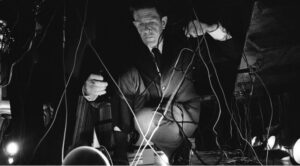Synopsis
Part circus and part meditation, John Cage’s cycle of works called the Europeras is serious fun. It’s been called “the great American opera,” which is a somewhat tongue-in-cheek assessment, since all of the music comes from classics of the European canon. But “only an American could do it” – meaning the creative adaptation of pre-existing elements is so resonant of an American sensibility. And through an unexpected and chance-based combination, something new emerges.
Five works make up the Europeras cycle, which gradually diminish in scale and scope from the grand Europera 1 to the pocket-size Europera 5. Theatricality and artificiality give way as the pieces get smaller, as if Cage were trying to whittle opera down to its purest essence. Europeras 3 & 4 are the mid-point of the cycle and intended to be performed together. Europeras 3, with six singers, still carries a sense of a chamber opera, while the two performers in Europeras 4 brings us into to the intimacy of a song recital.
Everything is “recycled” in Europeras – the sets, props, and costumes all come from Detroit Opera warehouses, and the arias themselves come from the vast repertoire of European opera. Yet while there may be no correct way to experience the new work that Cage created from operatic history, I personally encourage you not to get caught up in trying to recognize arias or pinpoint which production a particular object or outfit may come from. This is not a test of your operatic knowledge, but an opportunity to reset all your expectations. Let yourself go to all the new combinations of sights and sounds that emerge – and then marvel that all of it arises from found objects. Familiar arias are meant to become something completely unfamiliar.
The Europeras offers the most profound exercise in spectatorial freedom you can find in all of opera. After all, in a conventional opera, there’s a story that you either relate to our you don’t. In the Europeras, there are so many stories running parallel, and the audience can dip in and out of them freely. A conventional operatic production consists of well-rehearsed arrangements of precise coordination between many factors. In the Europeras, all the individual elements are autonomous. In a conventional operatic composition, various voices harmonize to convey the composer’s intention. In Europeras, various voices interdependently weave in and out of each other to allow the audience the opportunity to create their own meaning. The tyrannical question “What does it mean?” is let go once we allow chance to dictate every decision. The potential meanings and the lack of a single meaning is yours to sit with, the way you would contemplate a natural landscape or observe a bustling town square.
When people habitually say “Sit back, relax, and enjoy” at an opera, I often want to encourage the opposite: “lean in and engage” is what I would rather invite you to do. But in the case of Europeras, easing into a state where your preconceptions of opera can be happily undermined is the best posture for experiencing this work. So relax and enjoy!
-Yuval Sharon, Gary L. Wasserman Artistic Director, Detroit Opera






























